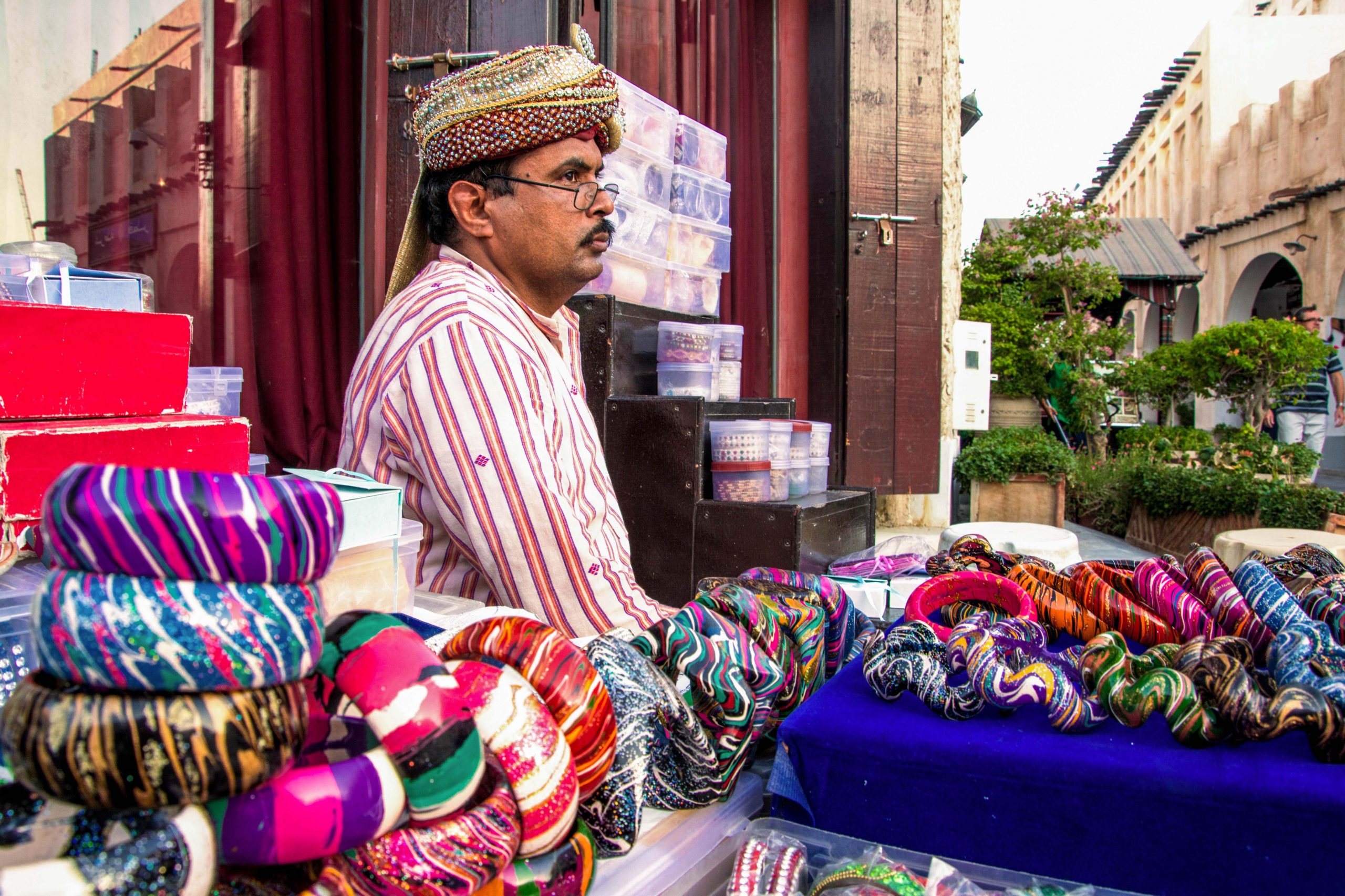
For Mohammed Aslam Maniyar, the world is literally a stage. The 45-year-old spends his days performing atop a short platform in the heart of Qatar’s Souq Waqif, twirling copper, resin and glitter over hot coals.
Especially on weekends, a rapt audience of locals, tourists, aged hamalis, and inquisitive children watch in awe as he weaves the elements together into a thick, colorful bangle.
Legendary Indian poet Sarojini Naidu once described bangles as “delicate, bright rainbow-tinted circles of light,” adorning the hands of mothers and maidens across India. But for Maniyar, these brittle bracelets are more than that – they’re his livelihood.
“I eat in this, I sleep in this, and I was born in this,” he said during a recent interview in Hindi, tinged with a native Rajasthani dialect.
Maniyar sings while he works, calling people to marvel at his crisp “tandoori” bangles, made on the same charcoal fire as the delicacies served inside the Royal Tandoor restaurant behind him.
The lyrics of his songs, infused with Arabic, Nepalese, Rajasthani and Hindi, are universal, and the message is simple – buy my bangles, buy a little bit of happiness.
“I do this to make people smile. Once I see the smile on my customer’s face, it’s all worth it,” he said.
Learning his craft
Maniyar began his career three decades ago in Jaipur, Rajasthan, a western Indian state known for its rich heritage and architecture. He said his grandfather began teaching him how to make bangles, a craft passed down for generations in his family, when he was 15 years old.
Once his training was complete, Maniyar began selling his bangles wholesale in Jaipur, before relocating to Mumbai in search of better opportunities. There, he spent over 20 years working in malls, hotels and restaurants.
Maniyar said he has also played an extra in the 2005 Bollywood film Paheli, made bangles for the wedding of Aishwarya Rai, and has met the likes of Shahrukh Khan and Rani Mukherjee, both renowned Indian movie stars.

His move to Qatar in 2007 was sudden, prompted in large part by the better benefits that a job here offered.
“I was working at the Orchid Hotel (in Mumbai) when Mr. William Aranha (the owner of the Royal Tandoor) walked in for dinner. He saw me, he liked me, I liked him, we fell in love, and I came here,” he said jokingly.
A job offer on the table, Maniyar left his wife and six children to begin anew here – though his 21-year-old son has recently joined him in Qatar also as a bangle-maker, albeit in a different store.
During his seven years here, Maniyar’s work has drawn the attention of several local newspapers and magazines. Laminated copies of the articles remain stacked in the corner of his makeshift booth as evidence of his years of dedicated work.
In Qatar, Maniyar works from 6pm to 1am each day, on commission. His housing, laundry and food are all taken care off by the owner of Royal Tandoor, but he receives no salary.
Instead, he collects 60 percent of all sales from bangles and other artifacts that he imports from Jaipur – earnings that he called “sufficient.”
Behind the scenes
Maniyar’s wife, a stay-at-home mother in Mumbai, helps Maniyar with his business remotely.
Born at a time when child marriage in India was the norm, Maniyar said he married his wife in 1982 – when he was 12, and she was nine years old. He explained:
“It was common in our time. Our parents chose our partner, and we got married. But we didn’t live together until much later. My wife came to me in 1992, not before. Now we can’t do this anymore. The government has all these rules – the guy has to be 21, and the girl 18, but in those days, this is what happened. Our culture is very strict.”

In charge of buying raw lac, the resin needed for the bangles, his wife processes it, colors it and ships it to Maniyar to use.
Lac is a resinous substance secreted by tiny insects who feed on the peepul or bodhi tree, considered holy by both Hindus and Buddhists.
The insects deposit the substance on the tree’s branches and trunk, where it is then scraped off and washed several times to remove impurities.
It is then melted; during this process, impurities in the lac settle down while the purer substance remains at the top. Once collected, it is then often infused with wax to increase the cohesiveness of the substance.
“The original color for this substance (lac) is red,” Maniyar said, pulling a thick saffron-colored cylindrical object from a bag.
“(My wife) buys the raw materials and then puts it in a kadai (a big steel pot) and put water over it. It is then melted and becomes like water…After you put it in the kadai and melt it, it spreads on the top. We collect it and put in colored powder. This powder is the same used to dyed clothes. It is then left to dry where it becomes….tight.”
The process
To make the bangles, Maniyar asks customers to choose the color, design and size of their choice.

He then melts different pieces of colored lac around a central stick, flattens and rolls it, and cuts it into a long rope-like piece. The long piece is then rolled around in glitter and joined into a seamless loop.
After that, he heats a thin wire bangle over the fire before pressing it onto the inside of the lac bangle. The bangle is then fitted over thick wooden stick to ensure uniformity of the finished product.
He finally pokes and pushes the substance into different designs. The entire process takes around five to seven minutes, and each piece costs about QR40 to 100.
When asked about the fruits of his labor, Maniyar said he has been proud to work in Qatar and represent his Indian craft.
“I’m pleased. I’ve made my name shine, my country shine, and my people shine. That’s enough for me.”
Thoughts?







